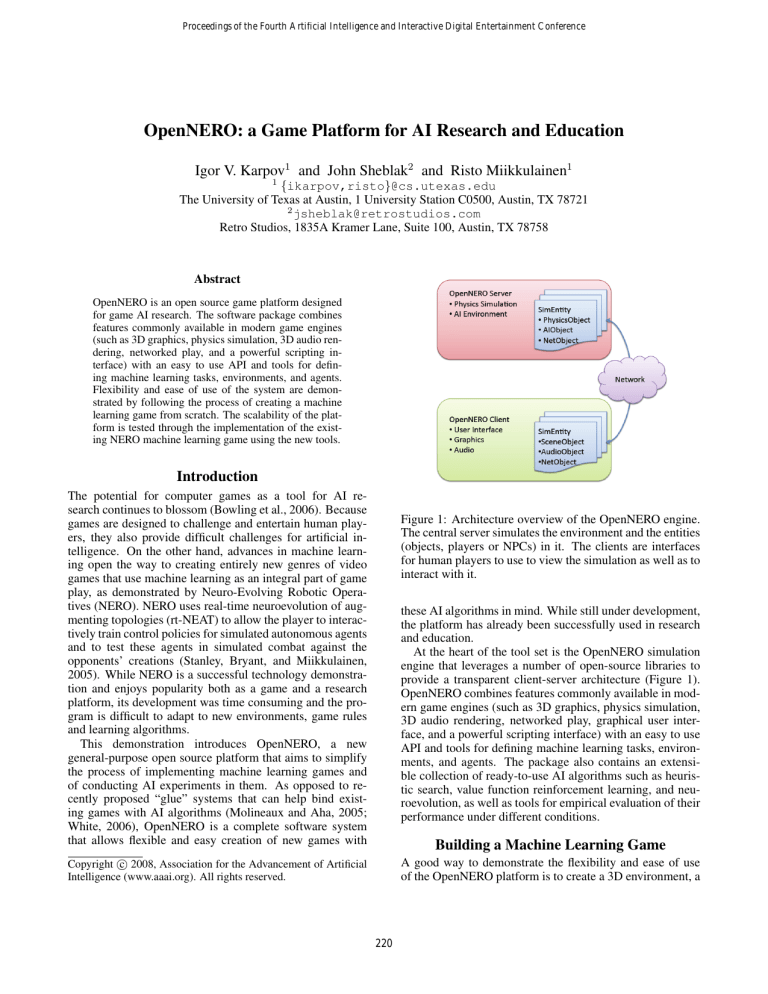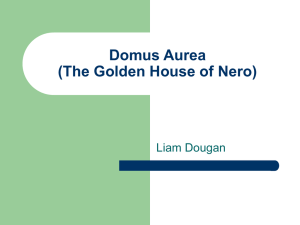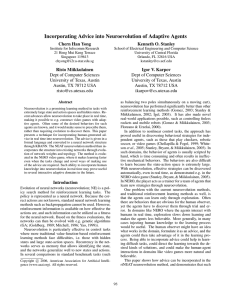
Proceedings of the Fourth Artificial Intelligence and Interactive Digital Entertainment Conference
OpenNERO: a Game Platform for AI Research and Education
Igor V. Karpov1 and John Sheblak2 and Risto Miikkulainen1
1
{ikarpov,risto}@cs.utexas.edu
The University of Texas at Austin, 1 University Station C0500, Austin, TX 78721
2
jsheblak@retrostudios.com
Retro Studios, 1835A Kramer Lane, Suite 100, Austin, TX 78758
Abstract
OpenNERO is an open source game platform designed
for game AI research. The software package combines
features commonly available in modern game engines
(such as 3D graphics, physics simulation, 3D audio rendering, networked play, and a powerful scripting interface) with an easy to use API and tools for defining machine learning tasks, environments, and agents.
Flexibility and ease of use of the system are demonstrated by following the process of creating a machine
learning game from scratch. The scalability of the platform is tested through the implementation of the existing NERO machine learning game using the new tools.
Introduction
The potential for computer games as a tool for AI research continues to blossom (Bowling et al., 2006). Because
games are designed to challenge and entertain human players, they also provide difficult challenges for artificial intelligence. On the other hand, advances in machine learning open the way to creating entirely new genres of video
games that use machine learning as an integral part of game
play, as demonstrated by Neuro-Evolving Robotic Operatives (NERO). NERO uses real-time neuroevolution of augmenting topologies (rt-NEAT) to allow the player to interactively train control policies for simulated autonomous agents
and to test these agents in simulated combat against the
opponents’ creations (Stanley, Bryant, and Miikkulainen,
2005). While NERO is a successful technology demonstration and enjoys popularity both as a game and a research
platform, its development was time consuming and the program is difficult to adapt to new environments, game rules
and learning algorithms.
This demonstration introduces OpenNERO, a new
general-purpose open source platform that aims to simplify
the process of implementing machine learning games and
of conducting AI experiments in them. As opposed to recently proposed “glue” systems that can help bind existing games with AI algorithms (Molineaux and Aha, 2005;
White, 2006), OpenNERO is a complete software system
that allows flexible and easy creation of new games with
Figure 1: Architecture overview of the OpenNERO engine.
The central server simulates the environment and the entities
(objects, players or NPCs) in it. The clients are interfaces
for human players to use to view the simulation as well as to
interact with it.
these AI algorithms in mind. While still under development,
the platform has already been successfully used in research
and education.
At the heart of the tool set is the OpenNERO simulation
engine that leverages a number of open-source libraries to
provide a transparent client-server architecture (Figure 1).
OpenNERO combines features commonly available in modern game engines (such as 3D graphics, physics simulation,
3D audio rendering, networked play, graphical user interface, and a powerful scripting interface) with an easy to use
API and tools for defining machine learning tasks, environments, and agents. The package also contains an extensible collection of ready-to-use AI algorithms such as heuristic search, value function reinforcement learning, and neuroevolution, as well as tools for empirical evaluation of their
performance under different conditions.
Building a Machine Learning Game
c 2008, Association for the Advancement of Artificial
Copyright Intelligence (www.aaai.org). All rights reserved.
A good way to demonstrate the flexibility and ease of use
of the OpenNERO platform is to create a 3D environment, a
220
with their associated “importance” weights. For the maze
game, the agent controls its angular and linear velocity,
receives a constant penalty for performing non-terminal
actions and a large positive reward for reaching the goal.
• Agent - The user defines the start, act and end methods
of an agent in script. Here, the user has all the algorithms
implemented in OpenNERO at his or her disposal. Example controllers for the maze environment include manual
control, A* search, Q-learning and neuroevolution.
In OpenNERO, creating environments, tasks and agents
can be done with only a small amount of Python code and
without recompiling any platform-dependent code. The end
result is a simple but full-featured 3D video game that can
be used as a visual aid for comparing different AI algorithms
(Figure 2).
Figure 2: Screen-shot of the maze environment. The maze
is randomly generated using a scripted Kruskal’s algorithm.
Such an environment can be used to demonstrate heuristic
search methods as well as machine learning methods such
as neuroevolution or reinforcement learning, as well as allowing the human players to try the task for themselves.
Scaling OpenNERO to NERO
In order to test the scalability of OpenNERO, the existing real-time neuroevolution game NERO is being reimplemented using the new tools. NERO is a computationally intensive game because it requires the simultaneous
calculation of ego-centric sensors and evaluation of control
policies for a population of 50 or more autonomous simulated agents every decision time step (usually on the order
of 0.1 sec). Currently, the NERO implementation matches
the capacity of an average consumer machine at population
sizes under a hundred agents. In the future, the OpenNERO
platform will be further extended to allow decision making
to be distributed over a network of computers, which should
reduce the load on the central simulation server and make it
possible to build more complex games.
simple game that involves a reinforcement learning task, and
to solve this task by using an existing reinforcement learning
agent. In order to do so, the user defines a randomly generated 2D maze with a start state and a goal state, defines the
task (the rules and the reward structure) of the game, and
defines two characters (player-controlled and non-playercontrolled) that will play this game. Each of the three components of this creation process - the environment, the task
and the agent - is described in more detail below.
• Environment - OpenNERO provides two tools, Importer
and Builder, that simplify the creation of virtual environments. The Importer tool allows the user to load 3D models in a variety of formats and to set OpenNERO specific properties such as physical attributes, animations,
and sounds. The Builder tool allows the user to place
different objects in the environment either manually or
programmatically and to preview the resulting world. It
also allows the user to adjust global constants that affect
the underlying physics simulation. For the maze environment, the environment consists of an island terrain and a
script that places the walls of the maze generated using
Kruskal’s algorithm.
Acknowledgments
This research was supported in part by NSF under
grant IIS-0757479, Texas Higher Education Coordinating Board under grant 003658-0036-2007, the College
of Natural Sciences at University of Texas under the
FRI program, and the IC2 Institute of the University
of Texas. OpenNERO uses several software packages
made available by their respective authors via licenses
approved by the Open Source Initiative.
References
Bowling, M.; Fürnkranz, J.; Graepel, T.; and Musick, R.
2006. Machine learning and games. Machine Learning
63:211–215.
Molineaux, M., and Aha, D. W. 2005. TIELT: A testbed for
gaming environments. In Proceedings of the Twentieth
National Conference on Artificial Intelligence (Intelligent
Systems Demonstrations). AAAI Press.
Stanley, K. O.; Bryant, B. D.; and Miikkulainen, R. 2005.
Evolving neural network agents in the NERO video game.
In Proceedings of the 2005 IEEE Symposium on Computational Intelligence and Games(CIG’05). IEEE.
White, A. 2006. A standard system for benchmarking in
reinforcement learning. Master’s thesis, University of Alberta.
• Task - The user can define tasks in the game as a reinforcement learning problem by defining the environment logic that takes in actions to produce sensors and rewards that are then consumed by the players or non-player
characters. The sensors can query the simulation using
parametrisation of a number of predefined queries such as
a virtual camera, a virtual microphone, virtual range sensors, object counters and filters. Actions are currently represented as vectors with variable number of dimensions;
individual components of an action vector have a minimum and a maximum value and can be either discrete or
continuous. The reward is either a single continuous number or a set of several rewards along multiple objectives
221




